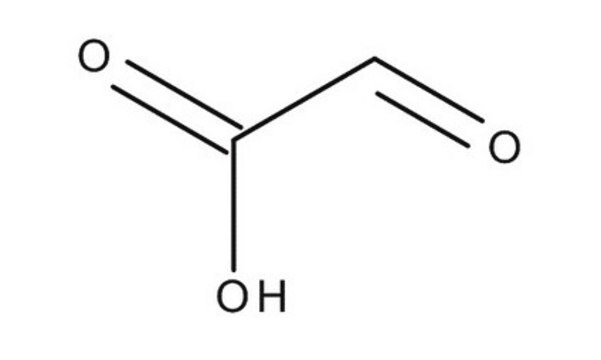1.00804
L(+)-Tartaric acid
for analysis EMSURE® ACS,ISO,Reag. Ph Eur
Synonym(s):
L(+)-Tartaric acid, 2,3-Dihydroxybutanedioic acid
About This Item
Recommended Products
grade
ACS reagent
Quality Level
Agency
reag. ISO
reag. Ph. Eur.
suitable for EPA 200.7
suitable for EPA 200.8
vapor pressure
<5 Pa ( 20 °C)
product line
EMSURE®
Assay
≥99.5-101.0% dry basis (alkalimetric)
form
solid
autoignition temp.
425 °C
impurities
≤10 ppm Phosphate (PO4)
≤100 ppm Sulfated ash
≤20 ppm Total sulfur (as SO4)
≤350 ppm Oxalic acid
≤5 ppm Chloride (Cl)
≤50 ppm Insoluble matter
≤50 ppm Sulfate (SO4)
loss
≤ 0.2% loss on drying, 105°C
pH
1.6 (25 °C, 100 g/L in H2O)
mp
168-170 °C
transition temp
flash point 210 °C
solubility
water: 1390 g/L at 20 °C
density
1.76 g/cm3 at 20 °C
bulk density
1000 kg/m3
cation traces
Ca: ≤20 ppm
Cu: ≤5 ppm
Fe: ≤5 ppm
Pb: ≤5 ppm
heavy metals (as Pb): ≤5 ppm
storage temp.
2-30°C
InChI
1S/C4H6O6/c5-1(3(7)8)2(6)4(9)10/h1-2,5-6H,(H,7,8)(H,9,10)
InChI key
FEWJPZIEWOKRBE-UHFFFAOYSA-N
Application
- Binary Mixtures of Meloxicam and L-Tartaric Acid for Oral Bioavailability Modulation of Pharmaceutical Dosage Forms.: This study explores the use of L(+)-tartaric acid in binary mixtures to enhance the oral bioavailability of meloxicam, suggesting potential applications in developing more effective pharmaceutical formulations (Macasoi et al., 2024).
- Hyper-Raman spectroscopy of biomolecules.: This research employs Hyper-Raman spectroscopy, an analytical technique enhanced by L(+)-tartaric acid, to provide insights into the structural dynamics of biomolecules, showcasing its utility in complex biological systems (Marble et al., 2024).
- Novel multi-component crystals of berberine with improved pharmaceutical properties.: This study highlights the use of L(+)-tartaric acid in the development of novel multi-component crystals, potentially leading to pharmaceuticals with enhanced efficacy and stability (Zhang et al., 2023).
- Deep Eutectic Solvent (DES)-Mediated One-Pot Multicomponent Green Approach for Naphthalimide-Centered Acridine-1,8-dione Derivatives and Their Photophysical Properties.: Research demonstrates the synthesis of complex organic compounds using L(+)-tartaric acid as a component of a deep eutectic solvent, highlighting its role in green chemistry (Rather et al., 2022).
Linkage
Analysis Note
Assay (alkalimetric, calculated on dried substance): 99.5 - 101.0 %
Identity: passes test
Appearance of solution: passes test
Insoluble matter: ≤ 50 ppm
Spec. rotation [α²0/D (20 %; water calculated on dried substance): 12.0 - 12.8 °
Chloride (Cl): ≤ 5 ppm
Phosphate (PO₄): ≤ 10 ppm
Sulfate (SO₄): ≤ 50 ppm
Heavy metals (as Pb): ≤ 5 ppm
Total sulfur (as SO₄): ≤ 20 ppm
Ca (Calcium): ≤ 20 ppm
Cu (Copper): ≤ 5 ppm
Fe (Iron): ≤ 5 ppm
Pb (Lead): ≤ 5 ppm
Oxalate (C₂O₄): passes test
Oxalic acid: ≤ 350 ppm
Sulfated ash: ≤ 100 ppm
Loss on Drying (105°C): ≤ 0.2 %
Corresponds to ACS,ISO,Reag. Ph Eur
Legal Information
Signal Word
Danger
Hazard Statements
Precautionary Statements
Hazard Classifications
Eye Dam. 1
Storage Class Code
11 - Combustible Solids
WGK
WGK 1
Flash Point(F)
302.0 °F - closed cup
Flash Point(C)
150 °C - closed cup
Certificates of Analysis (COA)
Search for Certificates of Analysis (COA) by entering the products Lot/Batch Number. Lot and Batch Numbers can be found on a product’s label following the words ‘Lot’ or ‘Batch’.
Already Own This Product?
Find documentation for the products that you have recently purchased in the Document Library.
Customers Also Viewed
Related Content
This page is intended to make it easier to find the consumables you need based on the analytical method you’re using. Methods included on this page come from the EPA, Standard Methods and ASTM.
This page is intended to make it easier to find the consumables you need based on the analytical method you’re using. Methods included on this page come from the EPA, Standard Methods and ASTM.
This page is intended to make it easier to find the consumables you need based on the analytical method you’re using. Methods included on this page come from the EPA, Standard Methods and ASTM.
This page is intended to make it easier to find the consumables you need based on the analytical method you’re using. Methods included on this page come from the EPA, Standard Methods and ASTM.
Our team of scientists has experience in all areas of research including Life Science, Material Science, Chemical Synthesis, Chromatography, Analytical and many others.
Contact Technical Service





